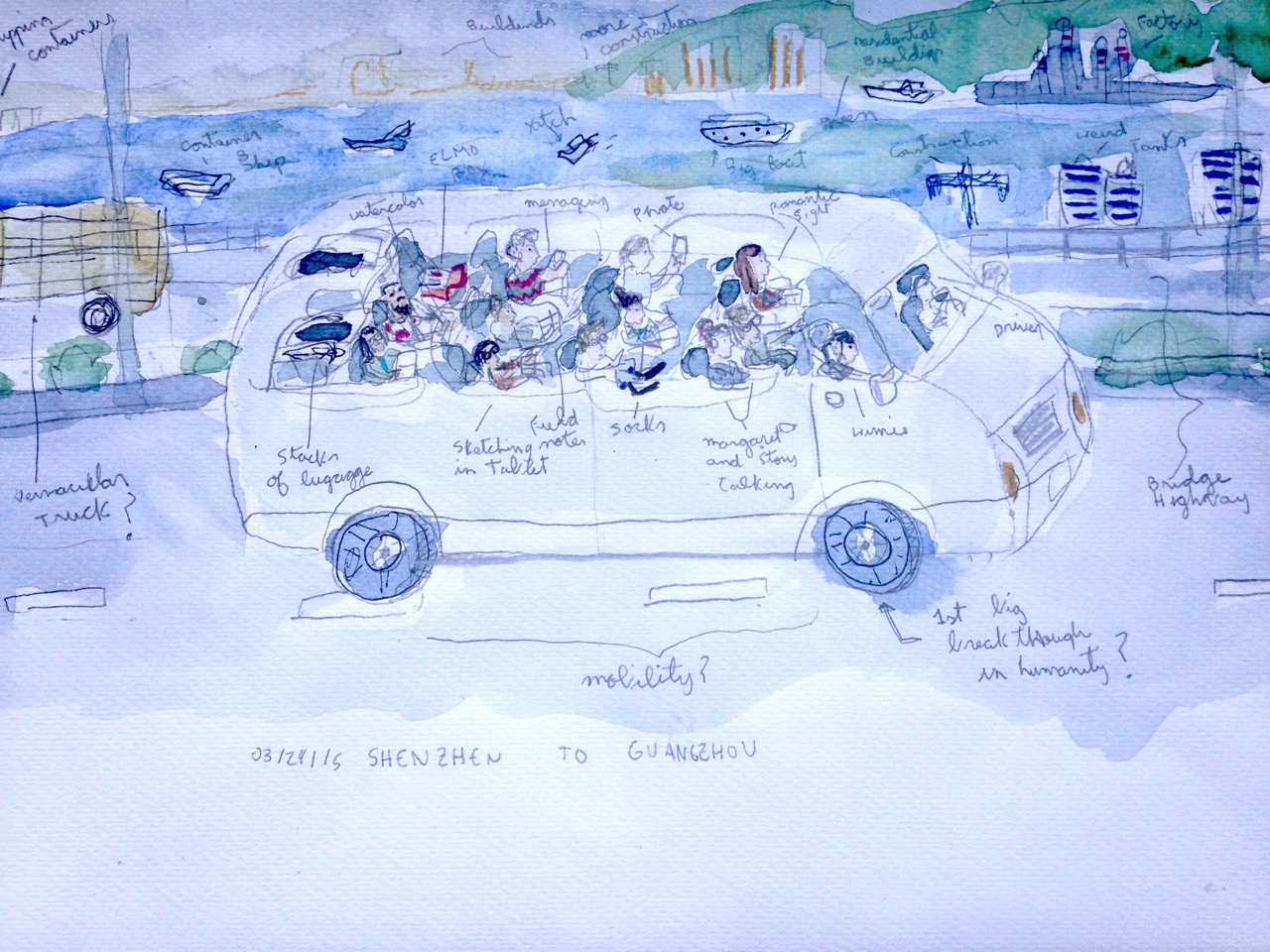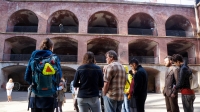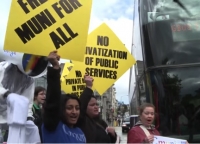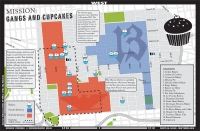GUH People: Jose Figueroa
Venezuelan-born artist currently based in Oakland, Jose Figueroa works in drawing, photography, video and sculpture. Best known for his map-like drawings that document his surroundings in playful detail, Figueroa is a keen observer of life. A self-described "impressionist," his recent travels to Paris, Cherry Grove and around San Francisco have provided much inspiration for his growing archive of queer spaces: clothing-optional beaches, clubs, among others. He studied at the Skowhegan School, Cooper Union (BFA) and received his MFA from the University of California, Berkeley. He was a graduate student in the 2015 GUH studio ART+VILLAGE+CITY in the Pearl River Delta (ARCH 209/RHETOR 205), co-taught by Margaret Crawford (Architecture) and Winnie Wong (Rhetoric).
.jpg) How did you first hear about the Global Urban Humanities Initiative and what made you want to join?
How did you first hear about the Global Urban Humanities Initiative and what made you want to join?
I first heard about the Global Urban Humanities in my first year as a master’s student of the Art Practice department. Some members of my cohort took a GUH studio course where they travelled to Los Angeles and they told me about the class exploring the Pearl River Delta next semester. I was deeply interested in the opportunity to do field practice in a foreign country and to engage in an interdisciplinary classroom. It was really insightful to connect with students from different fields with different concerns, research methodologies and intellectual products.
As a graduate student in the Art+Village+City studio, could you share your experiences participating in an interdisciplinary GUH studio?
I really value my memories of this class. I decided to document all our class meetings via watercolor paintings and I am so glad to have so many thorough maps of our classroom. There is a website with the process, experience and results of our field trip to the Pearl River Delta. Magaret Crawford and Winnie Wong were stellar mentors with whom I still keep connections with.
There are many unique memories of my 14 days in China. I remember going to an inflatable factory in industrial Guangzhou to produce an all white entryless bouncy castle. I remember going to Splendid China, the world's largest miniature park, reproducing attractions in China with my graduate advisor and Art Practice faculty Anne Walsh (who also taught the 2014 GUH studio on Los Angeles). I remember having tea with Professor Duan Qilai, the sculptor who created Lantau Island’s Big Buddha in his studio in Xiaozhou Village, and talking about objects of devotion and sites of pilgrimage. I remember also painting Dafen village’s colorful kindergarten located in the central square. Dafen oil painting village is the world's largest production center for replicas of famous oil paintings located in the city of Shenzhen. I attracted the attention of many children as well as tourists, visitors, and other painters who commented on my ability to represent the kindergarten building. This caught their eye because most painters in Dafen village paint from photographic sources and I like to paint from life.
Tell us a little bit about your current project/career and how GUH has shaped this.
After I graduated I’ve been paving a career in education and have been working with Richmond Youth. I also continued my studio practice at the Headlands Center for the Arts in Marin while pursuing other artist residencies in the US and abroad. Thanks to the Terra Foundation, I travelled to France to connect my practice to the Impressionist legacy through an immersive project with Claude Monet’s lily pond (that I am still dissecting). I recorded the iconic Golden Gate Bridge au plein air informed by photographer and geologist Mark Klett and the process of rephotography. I documented pool and beach scenes in the historical gay destination of Fire Island, NY where Oscar Wilde, Frank O’Hara and David Hockney left imprints. I would say that my time in the GUH initiative was crucial in developing elements of my ongoing observational drawing practice that responds to my surroundings as a handmade polaroid, allowing me to record more than meets the eye.

Jose Figueroa's watercolor of Art+Village+City students driving from Shenzhen to Guangzhou
Could you share one memorable moment you had as a GUH student?
I really enjoyed the time producing the exhibition highlighting the research we produced as a class. It was a pleasure to closely collaborate with Ettore Santi, Valentina Rozas-Krause and all our classmates and closely work with Winnie and Margaret. I remember we always got lunches from Babette’s.
Tell us one thing you are reading/watching/listening to that is helping you get through the quarantine.
I binge-watched Issa Rae’s Insecure and I was recently introduced to Amy Sedaris’ Strangers with Candy. I started the quarantine season with a novel called Fiebre Tropical by Juliana Lopera, Colombian writer based in the Bay Area. I’ve been revisiting The Philosophy of Andy Warhol (From A to B and Back Again) and I have a copy of Angela Y. Davis’ If They Come in the Morning on top of my side table.
Trace Evidence: An Art Exhibition and Panel Discussion at Minnesota Street Project
 Trace Evidence Curated by Annie Malcolm and Rachelle Reichert Exhibition September 8th – 29th Opening event + Panel: September 11, 2018 Minnesota Street Project, San Francisco Trace Evidence is an exhibition and a panel discussion at Minnesota Street Project, in partnership with SFMOMA Public Dialogue, in which the curators—2019 GUH Fellow Annie Malcolm and artist Rachelle Reichert—will convene visual artists from China and the U.S. who are considering issues of environmental change focused on China. Trace Evidence will take place in San Francisco in September 2018, during the Global Climate Action Summit, and is formally affiliated with GCAS. The curators…
Trace Evidence Curated by Annie Malcolm and Rachelle Reichert Exhibition September 8th – 29th Opening event + Panel: September 11, 2018 Minnesota Street Project, San Francisco Trace Evidence is an exhibition and a panel discussion at Minnesota Street Project, in partnership with SFMOMA Public Dialogue, in which the curators—2019 GUH Fellow Annie Malcolm and artist Rachelle Reichert—will convene visual artists from China and the U.S. who are considering issues of environmental change focused on China. Trace Evidence will take place in San Francisco in September 2018, during the Global Climate Action Summit, and is formally affiliated with GCAS. The curators…
Reawakening the Sensory Network
 On Saturday, February 27, Ava Roy, Artistic Director of the We Players site-integrated theater group led students in a workshop at the foot of the Golden Gate Bridge to learn methods of using movement and bodily awareness to investigate public spaces. For a complete description of the workshop, which was sponsored by the Global Urban Humanities Initiative, and other experiments in dance and architecture, see this blogpost. REAWAKENING THE SENSORY NETWORK by Jason Prado, Master in Landscape Architecture candidate My recent fascination with Lawrence Halprin's design process and the development of my studio design is what brought me to Ava Roy's…
On Saturday, February 27, Ava Roy, Artistic Director of the We Players site-integrated theater group led students in a workshop at the foot of the Golden Gate Bridge to learn methods of using movement and bodily awareness to investigate public spaces. For a complete description of the workshop, which was sponsored by the Global Urban Humanities Initiative, and other experiments in dance and architecture, see this blogpost. REAWAKENING THE SENSORY NETWORK by Jason Prado, Master in Landscape Architecture candidate My recent fascination with Lawrence Halprin's design process and the development of my studio design is what brought me to Ava Roy's…
On Choreography, Power and Public Space
by Susan Moffat, Project Director, Global Urban Humanities Initiative How do bodies construct and inhabit public space? In the past week I had the opportunity to participate in three transformative workshops—two sponsored by the Global Urban Humanities Initiative--that used dance, movement, and mindfulness to explore public space. Teatro Campesino in Wurster Hall, the Central Valley and Mexico City 2/25/2016 In a narrow, high-sided concrete courtyard hidden in an outdoor corner of the Brutalist Wurster Hall, Kinan Valdez of Teatro Campesino asked students and faculty to growl and shout; to walk, crawl, and leap; and to engage with props such as…
Art+Village+City: On Video as a Method and What Constitutes a “Site”
Art+Village+City in the Pearl River Delta is one of two interdisciplinary courses being sponsored by the Global Urban Humanities Initiative in Spring 2015. Students in this research studio are utilizing a variety of research methods from interviews to video documentation to explore the ongoing evolution of relationships between urban and rural spaces and people, and the emerging role of the arts in China’s Pearl River Delta. The research studio paired up in teams and produced 7 short videos depicting a “Chinese” site. These sites were the Pacific East Mall in El Cerrito, Oakland’s Chinatown, San Francisco’s Chinatown, and two dollar-stores…
Redirecting the Relationship Between Tech and Innovation
 As part of the Global Urban Humanities Initiative Colloquium called Reading Cities, Sensing Cities we have asked students and visitors to write responses to each of the weekly guest lectures. October 16, 2014 Creative Class Civil Wars: Displacement and the Arts in the Bay Area Shannon Steen (Theater, Dance, and Performance Studies) Presentation available here. Video of the conversation available here. Steen presented research from her project “Creative Class Civil Wars,” which explores the ways our concepts of creativity are shifting to exclude those in the arts. by Robyn Perry "The notion that diversity in an early team is important…
As part of the Global Urban Humanities Initiative Colloquium called Reading Cities, Sensing Cities we have asked students and visitors to write responses to each of the weekly guest lectures. October 16, 2014 Creative Class Civil Wars: Displacement and the Arts in the Bay Area Shannon Steen (Theater, Dance, and Performance Studies) Presentation available here. Video of the conversation available here. Steen presented research from her project “Creative Class Civil Wars,” which explores the ways our concepts of creativity are shifting to exclude those in the arts. by Robyn Perry "The notion that diversity in an early team is important…
From Bricks to Bus Stops: Protesting San Francisco’s Second Tech Boom
 As part of the Global Urban Humanities Initiative Colloquium called Reading Cities, Sensing Cities we have asked students and visitors to write responses to each of the weekly guest lectures. October 16, 2014 Creative Class Civil Wars: Displacement and the Arts in the Bay Area Shannon Steen (Theater, Dance, and Performance Studies) Presentation available here. Video of the conversation available here. Steen presented research from her project “Creative Class Civil Wars,” which explores the ways our concepts of creativity are shifting to exclude those in the arts. by Will Payne Shannon Steen’s presentation about the shifting role the term “creative”…
As part of the Global Urban Humanities Initiative Colloquium called Reading Cities, Sensing Cities we have asked students and visitors to write responses to each of the weekly guest lectures. October 16, 2014 Creative Class Civil Wars: Displacement and the Arts in the Bay Area Shannon Steen (Theater, Dance, and Performance Studies) Presentation available here. Video of the conversation available here. Steen presented research from her project “Creative Class Civil Wars,” which explores the ways our concepts of creativity are shifting to exclude those in the arts. by Will Payne Shannon Steen’s presentation about the shifting role the term “creative”…
Road-Testing Psychogeography on Oakland’s International Boulevard
 As part of the Global Urban Humanities Initiative Colloquium called Reading Cities, Sensing Cities, we have asked students and visitors to write responses to each of the weekly guest lectures. On September 4, 2014, Darin Jensen invited listeners to consider the narrative and spatial aspects of two experiential mapping projects he created with his students: Mission Possible: A Neighborhood Atlas about San Francisco's Mission District, and Intranational International Boulevard about Oakland. Jensen is staff cartographer and lecturer in the UC Berkeley Department of Geography. His presentation is available here. Video of the first portion of his presentation is available here. By Scott Elder While not…
As part of the Global Urban Humanities Initiative Colloquium called Reading Cities, Sensing Cities, we have asked students and visitors to write responses to each of the weekly guest lectures. On September 4, 2014, Darin Jensen invited listeners to consider the narrative and spatial aspects of two experiential mapping projects he created with his students: Mission Possible: A Neighborhood Atlas about San Francisco's Mission District, and Intranational International Boulevard about Oakland. Jensen is staff cartographer and lecturer in the UC Berkeley Department of Geography. His presentation is available here. Video of the first portion of his presentation is available here. By Scott Elder While not…
Maps as Stories: Manufacturing Place
 As part of the Global Urban Humanities Initiative Colloquium called Reading Cities, Sensing Cities, we have asked students and visitors to write responses to each of the weekly guest lectures. On September 4, 2014, Darin Jensen invited listeners to consider the narrative and spatial aspects of two experiential mapping projects he created with his students: Mission Possible: A Neighborhood Atlas about San Francisco's Mission District, and Intranational International Boulevard about Oakland. Jensen is staff cartographer and lecturer in the UC Berkeley Department of Geography. His presentation is available here. Video of the first portion of his presentation is available here.…
As part of the Global Urban Humanities Initiative Colloquium called Reading Cities, Sensing Cities, we have asked students and visitors to write responses to each of the weekly guest lectures. On September 4, 2014, Darin Jensen invited listeners to consider the narrative and spatial aspects of two experiential mapping projects he created with his students: Mission Possible: A Neighborhood Atlas about San Francisco's Mission District, and Intranational International Boulevard about Oakland. Jensen is staff cartographer and lecturer in the UC Berkeley Department of Geography. His presentation is available here. Video of the first portion of his presentation is available here.…




